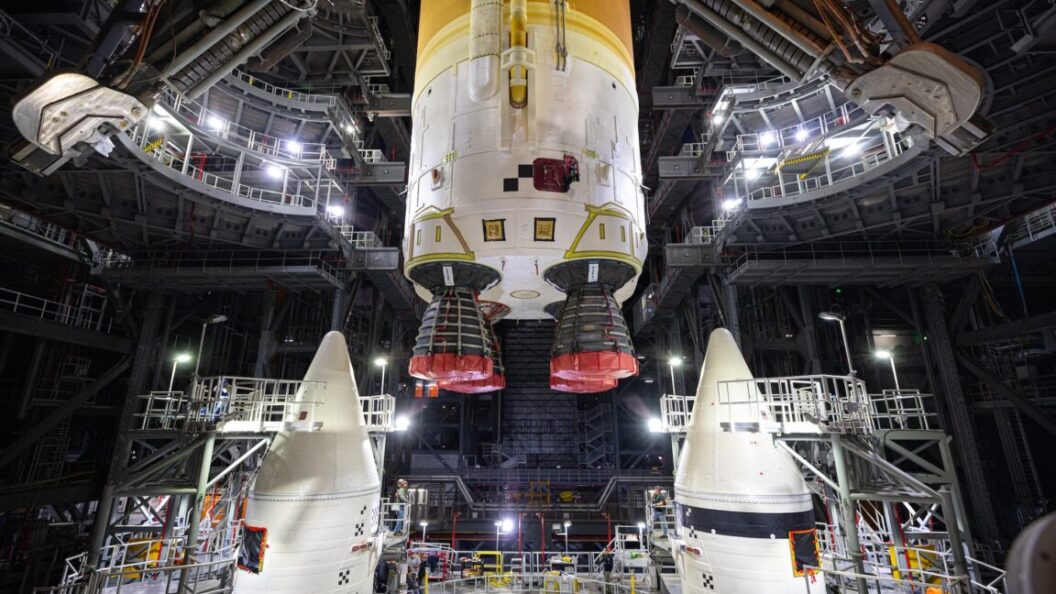NASA Moves Forward with Artemis II Mission at Kennedy Space Center
Late Saturday evening, technicians at Kennedy Space Center (KSC) executed a crucial operation by positioning the core stage of NASA’s second Space Launch System (SLS) rocket between its two solid-fueled boosters. This significant milestone enhances the progress of NASA’s Artemis II mission, which aims to send astronauts around the Moon.
Technical Maneuvering in the Vehicle Assembly Building
Inside the iconic 52-story Vehicle Assembly Building, ground teams utilized heavy-duty cranes to lift the core stage, recognized by its distinctive butterscotch orange color. The structure, measuring approximately 212 feet tall and weighing about 94 tons (85 metric tons), required intricate handling. Technicians first lifted the core stage from its cradle and rotated it vertically, subsequently disconnecting it from one of the cranes before maneuvering it into place using a 325-ton overhead crane.
This core stage is an essential component of the Artemis II mission, which is scheduled to launch as early as next year. It will carry about 730,000 gallons of cryogenic propellant at liftoff. Following the successful placement of the core stage between the SLS’s twin solid rocket boosters on a mobile launch platform, crews on the ground began connecting various load-bearing attach points.
Creating a Platform for Astronaut Exploration
Following the installation of the core stage, workers connected it to the solid rocket boosters and set up the necessary electrical and data connections. Subsequent steps will include stacking a cone-shaped adapter on top of the core stage, followed by attaching the rocket’s upper stage and an additional adapter ring, ultimately culminating in the placement of the Orion spacecraft. This spacecraft will serve as the living quarters for a four-person Artemis II crew during their 10-day journey through deep space.
NASA’s Artemis program represents a significant step forward in human space exploration, with Artemis II slated to be the first crewed flight of the initiative. Marking the first time astronauts will travel beyond low Earth orbit since 1972, the mission aims to take a crew around the Moon without landing. Future missions, such as Artemis III, plan to land astronauts on the lunar south pole and establish a sustainable human presence on the Moon.
Artemis Program: Beyond the Moon to Mars
The Artemis program’s vision extends further, as it looks toward establishing a long-term human presence on the Moon, which could serve as a springboard for potential missions to Mars. NASA’s current plans include leveraging SpaceX’s Starship rocket as a human-rated lunar lander for future missions, introducing new complexities in crew logistics and exploration technology. Each step taken in this ambitious program is designed to foster human capability and technology development for interplanetary exploration.
Significance and Future Implications
The successful integration of the SLS core stage represents a pivotal moment in the Artemis program, reflecting not only NASA’s commitment to returning humans to the Moon but also to expand humanity’s reach into space. The Artemis II mission will exemplify international cooperation in space exploration and represent a hopeful beacon for future endeavors.
As NASA continues to develop its crewed lunar missions, stakeholders will monitor progress keenly, analyzing how technological advancements and mission successes might best position humanity for its next giant leap into the cosmos. The Artemis program is not just about lunar exploration; it’s a foundational step toward interplanetary presence, with Mars on the horizon.
In conclusion, as crews prepare for Artemis II, enthusiasm mounts over the potential scientific discoveries and international collaboration that await beyond our home planet, marking a golden era for space exploration. The mission symbolizes a return to exploration, pioneering the path for future generations to follow in the footsteps of astronauts who first ventured into deep space.









